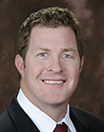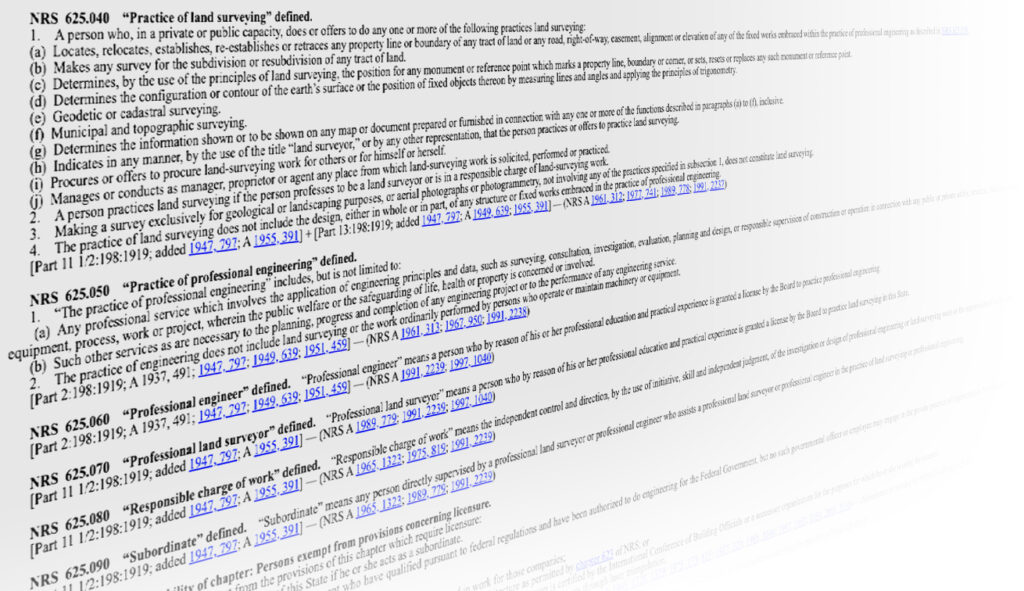CHAIRWOMAN'S MESSAGE

Ms Purcell was elected by the state board to serve as chairwoman effective July 1, 2019. She was initially appointed to the board by Governor Brian Sandoval July 1, 2015. Governor Sandoval reappointed Karen, July 1, 2018, to serve her second three-year term.
I’m honored to be elected by my fellow board members to serve as chair of the board. I follow excellent past-chairs and have learned much from them. I am committed to continuing to do all that I can to improve Nevada’s regulatory processes in support of growing and diversifying Nevada’s economy.
Thank you to past chairman Bob LaRiviere, PLS for his steady leadership guiding the board through two years of dynamic activity and accomplishment. Much was done during his tenure to ensure the board’s business ran smoothly. Bob’s steady leadership guided the board through many changes— updating laws and regulations, legislative sunset review, executive branch audits, creating a business plan, re-establishing a Las Vegas office, and relocating the Reno office. The positive changes were highlighted in February 2019 when the board was recognized as a Cashman Good Government award finalist.
As the board continues to change, as new members are appointed, the strategic plan—developed while Bob served as vice chair—will drive strategies and action items in the next three to five years. The strategic plan, available on the board’s website, https://nvbpels.org, will serve as our touchstone as I guide the board during the next year.
As stated in the board’s strategic plan, the board exists to regulate the engineering and land surveying professions—ensuring competent, qualified professionals serve the public in a manner that protects public health safety and welfare. For many years the board has operated under the radar, carrying out its obligations quietly without public attention. As we look to the future, we realize the board is a mystery to most professionals, despite the board regularly inviting professionals as guest members to board meetings. And, the public generally doesn’t know we exist unless they need to file a complaint.
During the upcoming year, the board plans to gently edge on to the radar by easing into the realm of public outreach. The goal is to articulate the simplified licensing process – application process and requirements, time frames for approval, and mobility opportunities—and communicate the board’s commitment to constant review of statutes and regulations to ensure relevancy to current practices and practical application in a modern economic climate. We hope to help shine the light on all the amazing things professional engineers and land surveyors do to serve the public and our communities. Stay tuned!
On a closing note, the board welcomes offers to volunteer your time and talents. If you would like to be considered to be a guest board member or serve on a board advisory committee, please feel free to send an email to the board office, board@boe.state.nv.us.
Governor Appoints New Board Member

Matt is a licensed professional land surveyor in Nevada. His surveying career began with the Bureau of Land Management and he later worked in the private sector. Currently, Matt leads the Land Resources department for NV Energy’s northern service territory. Over the last twenty years he has been involved with a wide range of responsibilities in surveying and land rights related to the construction and operation of the expanding gas and electric utility infrastructure in Northern Nevada. One of the larger projects he has contributed to was the 500 kilovolt transmission line connecting northern and southern Nevada.
Matt graduated from the University of Nevada, Reno with a Bachelor of Arts in History and the Oregon Institute of Technology with a Bachelor of Science in Land Surveying. He has served as President of the Nevada Association of Land Surveyors and Chair of the Western Federation of Professional Surveyors.
Matt and his wife Laura live in Sparks and have two sons, Chad and Troy. Matt officiates high school football with the Northern Nevada Football Officials Association.
BOARD MEMBER REAPPOINTED

Tom currently is the Vertical Market Manager for Granite Construction and resides in Reno, NV. His primary responsibility at Granite is to grow the Vertical Construction group regionally. Prior to joining Granite, Tom worked for CH2M HILL as part of their Industrial and Advanced Technologies Group focusing on front-end solutions for high-tech clients. Tom earned his B.S. in Mechanical Engineering and his MBA from the University of Nevada, Reno. Since graduating with an engineering degree he has over 10 years of experience in both construction and engineering design work. Tom and his Wife Kara have two children, Kolten and Reese. For fun, Tom enjoys Skiing, Golfing, exercising and coaching his children’s various athletic teams. Tom is also an active board member for the University of Nevada Alumni Football Association and Strengthen the Pack, a fundraising group with a goal of assisting the University of Nevada, Reno in building nationally ranked athletic programs.
PROFESSIONAL ASSOCIATION EVENT CALENDAR
A Professional Associations Event Calendar has been added to the NVBPELS website. It’s designed as a one-stop resource for licensees to find out about professional engineering and land surveying related events happening in their community.
View the calendar at https://nvbpels.org/calendar
DIGITAL SIGNATURES

What is a digital signature?
Is an electronic signature a digital signature?
Definition of a digital signature from the Oxford Dictionary, “A digital code (generated and authenticated by public key encryption) which is attached to an electronically transmitted document to verify its contents and the sender’s identity.” A digital signature contains encryption protections using a set of algorithms to determine authenticity of a document. It’s a digital fingerprint – a way to protect and verify a document hasn’t been tampered with during transmission between parties.
An electronic signature is not a digital signature. Electronic signatures do not provide the same level of security as digital signatures and do not meet the requirements to comply with Nevada law.
Nevada Administrative Code—
NAC 625.610 Stamps, seals and signatures on documents; revision of original plans.
10. A licensee with responsible charge of the work contained in a document … may have an electronically prepared seal and digital signature applied to such a document which is electronically submitted, released or issued only if:
(a) The files containing the document are locked electronically to prevent any changes to the document;
(b) Secure encryption methods are in place to prevent the copying, transferring or removing of the seal and digital signature and to prevent changes to any electronic drawings after the document is submitted, released or issued; and
(d) The licensee believes adequate protections are in place to prevent fraud or misuse of the digital signature.
A digital signature has the following properties:
- The signature can only be created by someone who knows the secret information
- Once a signature is created, anyone can validate that the signature is associated with the individual and the document, without needing to know the secret information used to create the digital signature
- Since the signature depends on the document, it cannot be used to validate a different document
A digital signature protects licensees and their work. While a digital signature cannot completely prevent fraud, it adds a level of security, making it difficult to copy information from an electronic document. A common misconception is an electronic signature, used to certify a document, satisfies the requirements of the law. Certifying, in addition to locking a document, does not comply with Nevada law. Applying a digital signature, secures the document with encryption methods, and complies with the law.
A common question that gets asked, “is putting an image of a licensee’s stamp with an image of the licensee’s signature on an electronic document a digital signature? The answer is no, that would still be considered an image of a signature, some may also call it an electronic signature. An image of a signature is not a digital signature. Again, a digital signature includes embedded meta-data and provides encryption to preclude altering the original document without invalidating the digital signature. The confusion comes from interchanging terms—electronic and digital. For engineering and surveying documents, to eliminate confusion, it is important to clearly distinguish between the two words, and consistently use the proper term.
Creating a digital signature is easy and costs nothing. It can be created in a variety of software programs. The City of Denver has an excellent step-by-step guide for using digital signatures with engineering and surveying documents in Adobe and BlueBeam—
Digital signatures create the ability to transmit documents electronically, saving time and money. Instead of printing, wet stamping, and signing multiple sheets and multiple plan sets, a digital signature can be applied in a matter of minutes or even seconds, if batch applied. Benefits of electronic submittals include—
- An electronic trail is created and can be followed to see who opened the document
- Documents can be instantaneously sent to multiple departments within an agency for concurrent reviews
- Eliminates paper and printing costs
- Eliminates shipping costs for stamping and signing by multi-disciplines
- Processing time can potentially be significantly reduced
An important note – once a project or document has been electronically submitted with a digital signature it stays electronic through the entire permitting process. There are different levels of security, depending on which program was used to create the digital signature, to allow for electronic commenting and mark up by the reviewing agency. So, when the documents are submitted to the review agency, they should not be fully locked. The agencies reviewing the documents will mark up and add comments electronically then send back to the licensee. The licensee will make the changes then, again, digitally sign using their digital signature and send back to the agency for review once more. This process continues until the final document is created and then it can be fully locked for archiving.
Of course, this all sounds quick and easy, but the reality is it will take time to implement digital signatures and electronic submittals, as agencies learn and create guidelines and become equipped to handle electronic submittals. We encourage licensees and agencies to share ideas with us to make the transition to electronic submittals efficient and smooth. The technology for digital signatures is here, it is no longer a matter of “if” agencies will eliminate paper and only accept electronic submittals, it’s a matter of “when”. It’s going to be a learning process and we want to be a resource as agencies work toward standardizing requirements that conform with Nevada law.
NRS AND NAC UPDATES

During 2019 the board updated its laws and regulations, Nevada Administrative Code 625 and Nevada Revised Statutes 625, to better align with current practices. Changes to regulations became permanent on January 30, 2019, and changes to law became effective July 1, 2019.
Extensive outreach was undertaken to engage professionals and professional societies. Professionals were sent a survey to determine potential impacts and solicit input on the changes. Public workshops were held in southern and northern Nevada to solicit input. Professional societies were regularly updated on regulation and law changes at the board’s Professional Association Liaison Committee meetings, held every other month. And, in some instances, board members met specifically with affected professional organizations to discuss changes and receive input. There was also opportunity to provide input through the Legislative Counsel Bureau process for the regulation changes, and for changes to the law, through legislators during the recent legislative process.
Changes to the regulations become permanent when the Legislative Counsel Bureau took final action on January 30, 2019. Below is a summary of the regulation changes—
NAC 625.260 clarifies upper point of reference in determining the 45-foot height limitation for civil engineers who perform structural design. And, adds the requirement that structural engineers design facilities and structures designated as essential facilities assigned a IV Risk Category in accordance with the International Building Code—hospitals, fire stations, hospitals, etc.
Why the change? Requiring essential structures to be designed by structural engineers is intended to enhance public health, safety, and welfare. Significant portions of Nevada’s population reside in areas with high seismic activity, areas that are classified by the USGS as the two highest levels of hazard. During a catastrophic seismic event, essential facilities include buildings such as hospitals, fire stations, and schools would be occupied by the public and first responders.
NAC 625.545 adds the requirement for a professional to contractually disclose to a client whether the professional maintains professional liability insurance.
Why the change? Adding this requirement requires the professional to contractually disclose whether they carry professional liability insurance, allowing the client to make a better informed decision in hiring a professional.
NAC 625.610 updates language related to stamps, seals, and signatures. Including language associated with electronic submittals and digital signatures.
Why the change? The change adds flexibility in obtaining a professional stamp/seal. Licensees no longer need to coordinate with the board in procuring their stamp. And, the change adds clarity to electronic submittals and digital signature requirements.
NAC 625.630 updates language to eliminate the “brick and mortar” requirement. Firms are no longer required to have a full-time engineer in each office that provides services. A firm still needs a professional in responsible charge, but can have multiple offices with a single professional in responsible charge.
Why the change? The intent of the change is to reduce barriers to trade and competition and also enhance the economic opportunities of Nevada small businesses. A firm still needs a professional in responsible charge, but can have multiple offices with a single professional in responsible charge.
Changes to the law became effective July 1, 2019. Below is a summary of the law changes—
NRS 625.203, NRS 625.285, NRS 625.386 sections 1.b. and 2.b. were removed from law as they are outdated and no longer applicable.
Why the change? The statutes were part of the “donut-hole-law”, a period of time when the laws transitioned from allowing the alternative pathway to licensure, experience without a degree, to the sole pathway of requiring a degree. Because the statutes timed out and are no longer valid, the expired laws needed to be removed. Also, because education acceptable to the board has been a requirement for licensure since 2010, it was timely to update the EI and LSI requirement. It was necessary to remove the experience pathway to certification, since this is no longer an experience pathway to licensure.
NRS 625.460 was modified to add enabling language to issue cease and desist orders.
Why the change? With the change, the board now has statutory authority to issue cease and desist orders against unlawful practice by an individual or firm.
NRS 625.407 removes the “brick and mortar” requirement.
Why the change? Firms are no longer required to have a full-time engineer in each office that provides services. A firm still needs a professional in responsible charge, but can have multiple offices with a single professional in responsible charge. The change benefits communities by increasing opportunities for new businesses and increasing competition and also benefits Nevada engineering and land surveying businesses. For example, an engineering firm in Elko in now enabled to open offices in Reno or Las Vegas since they would no longer be required to employ a full-time engineer in each office.
NRS 625.520 removes the board’s statutory obligation to protect the term “engineer”, when it is used outside the realm of engineering practice.
Why the change? Relaxing protections to the term “engineer” is necessary in balancing rights to free speech. For instance, when people or companies use terms such as Tire Engineer or Facilities Engineer, the titles are clearly not related to the practice of engineering. The board is no longer obligated by law to pursue/protect the term engineer in those instances.
NRS 329 was changed to limit survey corner records to a maximum of six survey corners. When recording more than six survey corners, a surveyor must now create a record of survey.
Why the change? The number six was chosen arbitrarily, but some number, a small number, was needed to preclude the increasing practice of using survey corner records for large numbers of corner records. When large numbers of survey corners are included in a survey corner record, it creates a muddled survey record, and creates challenges to deciphering the survey information. A survey corner record is just a written description and diagram of each survey corner, independent of all the other corners in the record. It does not include a drawing that depicts the relationship amongst all of the survey corners being recorded. Whereas a record of survey includes a drawing/map of all the survey corners along with all other required information for a record of survey.
Click here to review the updated laws and regulations. Please incorporate the law and regulation changes into your practice as applicable.
CHANGED ADDRESS OR CONTACT INFORMATION?
Send us an e-mail at board@boe.state.nv.us and include your name, license #, and the new address or contact information and we will update your file.
Nevada Board Compliance Actions
December 2018 – September 2019
COMPLIANCE CASE #: 20180020
RICHARD WARREN, PE # 017389
VIOLATION: NRS 625.410
DATE OF DISCIPLINARY ACTION: SEPTEMBER 12, 2019
A complaint was submitted against Mr Warren by the owner of custom home building company, alleging Mr Warren was responsible for flaws in the design of a residence resulting in structural deficiencies and that Mr Warren failed to cooperate to resolve the situation in a timely manner.
The custom home builder entered into a contract with Mr Warren to provide structural engineering and drafting services for the design of a custom home. Construction of the home was completed September 2015. After moving into the residence in October 2015, the homeowners immediately experienced cracks in the floors and walls.
Another engineering firm was retained to review Mr Warren’s calculations and drawings. The firm identified a structural deficiency, wherein the roof live and dead loads had not been called out at a girder truss support below a bearing wall. In addition, it was found that the girder truss was placed six inches away from the bearing wall where it should have been located below the main floor and adjacent to the great room fireplace.
NRS 625.410 states that the Board may take disciplinary action against a licensee for any gross negligence, incompetency or misconduct in the practice of professional engineering as a professional engineer. Here, Mr Warren acknowledges that he demonstrated incompetency by positioning the girder truss support in question six inches from where it should have been located, as well as failing to call out the line loads in the plans.
NRS 625.410(5) authorizes the State Board to take disciplinary action against a licensee for a violation of any provision of NRS Chapter 625 or NAC Chapter 625. Further. pursuant to NAC 625.640, this matter may be resolved without a formal hearing by Stipulated Agreement.
Mr Warren and the State Board hereby stipulate to the following terms for the above referenced violation(s):
- Mr Warren shall submit to Board staff a complete list and description of his projects from the time period of January 1, 2011 through December 31. 2015, that involved structural engineering undertaken by Mr Warren, and Board staff shall select three (3) to five (5) of those projects to be subjected to independent third-party peer review to evaluate Mr Warren’s structural competency as a civil engineer. The third-party engineer shall be selected by the Board staff, and the services thereof shall be paid for by Mr Warren upon presentment of invoice therefor. The third-party engineer shall have no conflict of interest relating to Mr Warren, this company, the custom home contractor, or the homeowners.
- While licensed professional engineers may provide limited structural engineering services without being a licensed structural engineer (NAC 625.260), Mr Warren shall be suspended from providing any structural engineering services for two (2) years immediately following acceptance of this Agreement by the State Board, but said suspension shall be stayed pending the independent third-party peer review required hereunder. Should the independent third-party peer review determine that Mr Warren is competent to provide the limited structural engineering services allowed by a licensed civil engineer, the suspension shall remain stayed for the remainder of the two (2) year time period, absent additional complaint(s) against Mr Warren.
- Mr Warren’s license shall be suspended for two (2) years immediately following acceptance of this Agreement by the State Board, pursuant to NRS 625.410 and NRS 625.460, but with the suspension stayed and probation imposed for the duration of that time period.
- The stay of Mr Warren’s license suspension may be lifted by the State Board upon notice and the opportunity for Mr Warren be heard should Mr. Warren fail to abide by the terms hereof.
- Mr. Warren’s successful completion of probation is expressly conditioned upon his full compliance with the following conditions of probation:
- Mr Warren shall submit detailed bi-monthly probation reports to the Executive Director of the Nevada Board, which shall report any work completed in Nevada during the previous two (2) month period. A report shall be filed even if no work was performed in Nevada during the previous two (2) month period. The first report shall be due within two (2) months of the effective date of this Stipulated Agreement. Each report shall include a copy of the contract executed for any work in Nevada, including the scope of work detail as well as supporting project documentation.
- Mr Warren shall pay an administrative fine of Seven Thousand Five Hundred and No/100 Dollars ($7,500.00);
- Mr Warren shall pay a portion of the assessed legal and investigative costs and fees incurred in this matter in the amount of One Thousand Six Hundred Sixty-Seven and 50/100 Dollars ($1,667.50).
COMPLIANCE CASE #: 20190001
ROBERT “DOOLEY” RIVA, PE # 018231
VIOLATIONS: NRS 625.520, NRS 625.565, NAC 625.510, AND NAC 625.610
DATE OF DISCIPLINARY ACTION: SEPTEMBER 12, 2019
Mr Riva allowed his license to lapse on December 31, 2009 and continued to practice professional engineering with an expired license until self-reporting to the board on January 10, 2019.
Mr Riva admitted, during the investigation in this matter, that he stamped, signed, and put false expiration dates for his license on the plans that he had submitted to reviewing agencies, as well as to his clients.
Mr Riva has maintained his California Professional Engineering license throughout this period from prior to December 31, 2009 to the present. Mr Riva’s California license is currently in good standing. A third-party competency review of a sampling of the thirty-seven (37) identified Nevada projects, that Mr Riva stamped while unlicensed has been completed, and his work was found to be competent.
NRS 625.410 states that the Board may take disciplinary action against a licensee for practicing after the license of the professional engineer has expired or has been suspended or revoked. NRS 625.520 also states that it is unlawful for any professional engineer to practice in a discipline of professional engineering in which the Board has not qualified him and for any person to use an expired license. Accordingly, NRS 625.565 makes it unlawful for any person to impress any documents with the stamp of a professional engineer after that person’s license has expired. In addition, NAC 625.610 requires that licensees include the date of expiration of his or her license on the stamp or seal. Moreover, under NAC 625.510, licensees must be honest and impartial, and serve their employers, clients, and the public with devotion. Mr Riva has violated the aforementioned provisions by continuing to practice professional engineering for nine (9) years after the expiration of his license and knowingly falsifying expiration dates when signing and stamping plans for submission to building departments for permits.
NRS 625.410(5) authorizes the State Board to take disciplinary action against a licensee for a violation of any provision of NRS Chapter 625 or NAC Chapter 625. Further, pursuant to NAC 625.640(3)(b)(2) this matter may be resolved without a formal hearing by Stipulated Agreement.
Mr Riva and the State Board hereby stipulate to the following terms for the above-referenced violation(s):
- Mr Riva’s license shall be reinstated and suspended for ten (10) years immediately following entry of this Agreement, but with the suspension stayed and probation imposed for the duration of that time period.
- The stay of Mr Riva’s license suspension may be lifted by the State Board upon notice and the opportunity for Mr Riva to be heard should Mr. Riva fail to abide by the terms hereof.
- Mr Riva’s successful completion of probation is expressly conditioned upon his full compliance with the following conditions of probation:
- Mr Riva shall pay all of the State Board’s legal and investigative costs associated with this matter, in the total amount of Two Thousand Three Hundred Fifty and No/100 Dollars ($2,350.00), which includes One Thousand Three Hundred Fifty and No/100 Dollars ($1,350.00) in legal fees and One Thousand and No/100 Dollars ($1,000.00) for the cost for a third-party competency review of a sampling of the thirty-seven (37) projects stamped by Mr Riva while practicing without a license. This payment is due to the State Board within thirty (30) days of the State Board’s acceptance and execution of this First Revised Stipulated Agreement.
- Mr Riva shall pay an administrative fine to the State Board in the amount of Fifteen Thousand and No/100 Dollars ($15,000.00), plus Two Hundred and No/100 Dollars ($200.00) for each of the thirty-seven (37) projects lawfully stamped by Mr Riva, for a total of Twenty-Two Thousand Four Hundred and No/100 Dollars ($22,400.00). Two Thousand Six Hundred Fifty and No/100 Dollars ($2,650.00) of this amount is due to the State Board within thirty (30) days of the Board’s acceptance and execution of this First Revised Stipulated Agreement. The balance thereof shall be due in five (5) equal annual installments of Three Thousand Nine Hundred Fifty and No/100 Dollars ($3,950.00). The first (1st) due on or before one year of the State Boards acceptance and execution of this First Revised Stipulated Agreement, and the remaining four payment due on or before each subsequent anniversary thereof, through the fifth (5th) anniversary of the State Boards acceptance and execution of this First Revised Stipulated Agreement.
- Mr Riva shall undertake and assume all costs associated with reviewing and re-stamping the drawings associated with the aforementioned projects that are on file with the appropriate building departments and provide the Board with sufficient proof thereof.
- Mr Riva registering in, paying for and completing an advanced level ethics course with Texas Tech University Murdough Center for Engineering Professionalism, and providing proof of completion thereof to Board staff within one (1) year of the date of full execution of this First Revised Stipulated Agreement.


